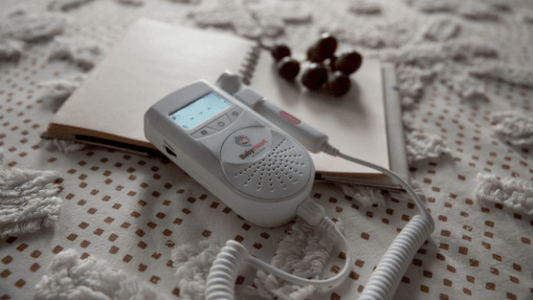
Hearing your baby’s heartbeat is a truly amazing experience!
At-home fetal dopplers make it possible to hear your baby’s heart rate and feel deeply connected to your little one.
Fetal dopplers are easy to use, but they’re also sensitive equipment, and sometimes you might detect other noises. Knowing how to use your doppler properly can make all the difference, so let’s run through some basics.
When you feel fully equipped to use your doppler, it will be an even more exciting experience to hear your little one’s beating heart.
What is a fetal doppler?
A fetal doppler, or a fetal heartbeat doppler, is a small hand-held device that you use to hear your baby’s heartbeat while they’re still in the womb.
A fetal doppler works by running a probe on top of ultrasound gel along your belly, similar to an ultrasound device that you’d see in your OBGYN’s office.
Depending on the model of fetal doppler that you’re using, you might hear the baby’s heartbeat through a built-in speaker on the device, or you may need to use headphones.
Why do expectant mothers love using a fetal doppler?
The benefits of using a fetal doppler include:
- Fetal dopplers help mother and baby feel more connected.
- Fetal dopplers help family and friends to connect with their new family member before the big arrival day.
- Fetal dopplers are a great way to help introduce children to their new sibling and to help fathers bond with their new baby before they arrive.
Top Tip: Fetal dopplers make a fantastic gift for an expecting mother. And we have multiple fetal doppler models available, so there’s something perfect for every family and every budget. Shop here
Our Top Tips For Finding Your Baby’s Heartbeat Using A Fetal Doppler
Tip 1: Don’t skimp on the gel!
If you’ve ever had an ultrasound, you’ll recall that the technician will apply a generous amount of ultrasound gel. This is because the gel makes it easier for the device to detect a heartbeat. Ultrasound gel works by reducing static, which can otherwise interfere with the signal.
Don’t worry about running out - at BabyHeart Australia, we’ve considered your every need any many of our fetal dopplers come with a FREE full-size bottle of ultrasound gel.
Application Tip: Gently apply the ultrasound gel in a layer to your lower belly - don’t rub it in like you would a moisturiser.
Tip 2: Have a full bladder
Many women find first thing in the morning to be the most effective time for finding the baby’s heartbeat - why not try jumping out of bed first thing in the morning and before you use the bathroom, see if you can find your little one’s heartbeat.
Having a full bladder helps to push your uterus out of the pelvic cavity, so the sound can be more easily detectable in this position.
Tip 3: Don’t rush
We know, it can be super exciting to try and find your baby’s heartbeat so it can be tempting to move the probe around as much as you can if you’re having trouble detecting the heartbeat at first. But slow and steady wins the race.
It’s a good idea to start with the probe around the middle of the pubic bone area, then work your way up the belly in a gentle rocking motion, going as slow and steady as you can.
Remember that your doppler can detect other noises too. By going slowly and gently angling the probe by rocking it as you move, you’ll have the best chance of finding your baby’s heartbeat using a doppler.

Tip 4: Know the difference between your heartbeat and baby’s heartbeat
Fetal dopplers can pick up on the mother’s heartbeat sometimes. Not sure which is which? A good rule of thumb is that your baby will usually have a higher heart rate than you.
Tip 5: Know what other sounds to look out for
When using a doppler, you’ll hear a variety of other sounds - one of the most common sounds is a ‘whooshing’ noise. This usually is heard when you move past the placenta, or when there’s movement in your belly.
The whooshing noise is not the same as your baby’s heartbeat.
You may also occasionally hear what sounds like two heartbeats at once, this is commonly caused by an echo and does not indicate that there are two heartbeats present (unless your doctor has indicated that you have multiple babies).
Tip 6: Try finding your own heartbeat first
If you’re not feeling confident about what sounds you can be listening for, you might like to try positioning the doppler probe over your chest and listening to your own heartbeat.
This will help you understand what you’re listening for and will teach you how to tell your heartbeat apart from your baby’s heartbeat. It will also let you know that your fetal doppler is working correctly.
Tip 7: Change positions
The most common position that you’re more likely to find your little one’s heartbeat is lying comfortably on your back, but if you find it uncomfortable to lie on your back, switch positions.
The more comfortable you are, the more relaxed you’ll be.
Other tips for using a fetal doppler to find your baby’s heartbeat
Remember, an at-home doppler doesn’t replace your check ups in any capacity so if you’re having trouble finding your little one’s heartbeat, always double-check your health with your doctor before jumping to any conclusions.
It can be helpful to take a little break if you’re struggling to find the heartbeat. It might be that it’s too early, or perhaps your baby is in a less than ideal position for hearing their heartbeat - take 5, take some time to relax and try again later.
Also make sure to keep your doppler’s probe clean, as a build-up of ultrasound gel can make it more difficult to find the heartbeat. Always wipe your device clean after every use.
If you suspect that something is wrong, get in touch with your doctor immediately.
Where do I buy a fetal doppler?
The best place to buy a fetal doppler is right here at BabyHeart Australia. Here, you’ll find a variety of fetal heartbeat monitors with different options to suit your needs.
The differences between models include LCD screens, built-in speakers vs. headphones and other advanced features, so take a moment to consider your needs and what you might like in a device.
And if you have any questions about which model to choose, our customer service experts are trained experts and we proudly offer a money-back guarantee.
Need help choosing the best fetal heartbeat doppler for your needs?
We’re more than happy to assist! Please feel free to give us a call and speak to our friendly customer advice team - we can help guide you on the best options for your needs and budget.
Or read more tips and tricks from our collection of blog articles.
It’s our privilege to be part of your journey.
Disclaimer: Our product is not a Therapeutic Good or a Medical Device, use it as a Lifestyle Tool

 Order today and receive a complimentary, large 250mL Gel valued at $19.99!
Order today and receive a complimentary, large 250mL Gel valued at $19.99!


